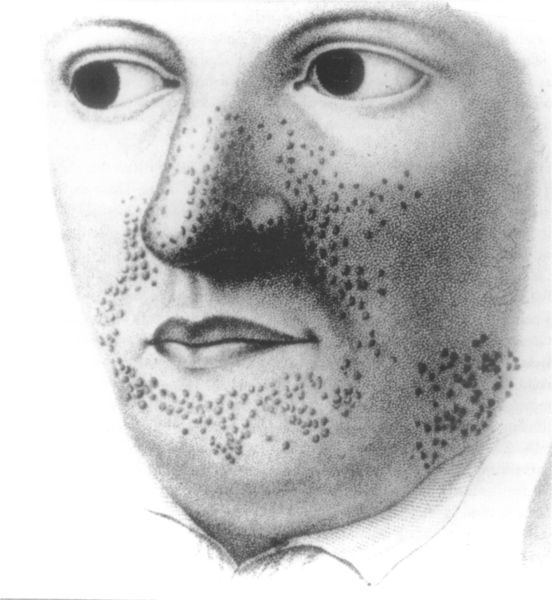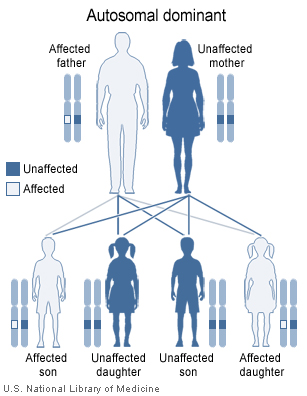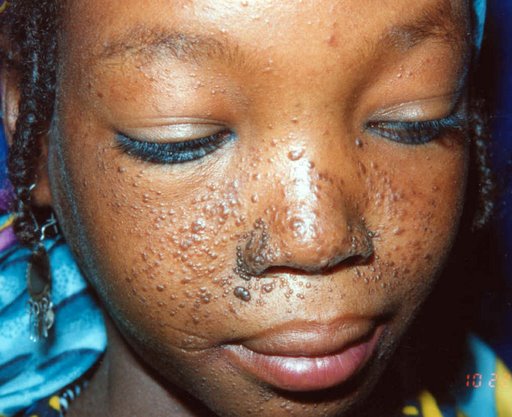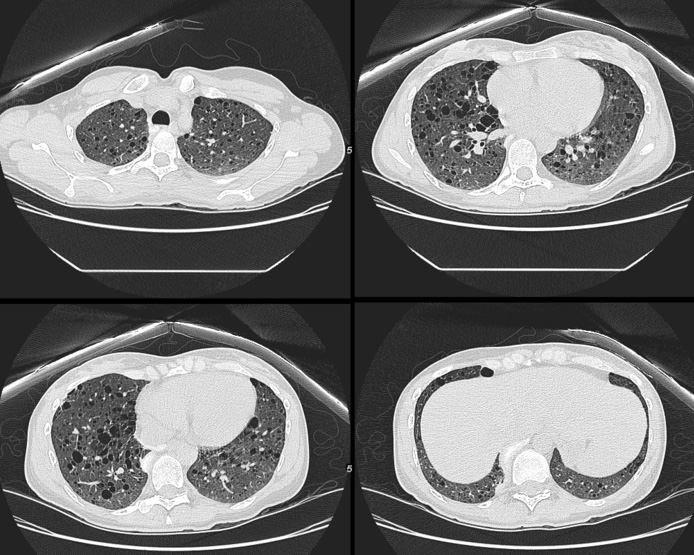Tuberous sclerosis
| Tuberous sclerosis | |
 | |
|---|---|
| Earliest illustration, from Rayer's atlas of skin diseases, 1835. | |
| ICD-10 | Q85.1 |
| ICD-9 | 759.5 |
| OMIM | 191100 |
| DiseasesDB | 13433 |
| MedlinePlus | 000787 |
| MeSH | D014402 |
For patient information on this page, click here
Editor-In-Chief: C. Michael Gibson, M.S., M.D. [1]; Associate Editor(s)-in-Chief: Raviteja Guddeti, M.B.B.S. [2]
Synonyms and keywords: Tuberous sclerosis complex, TSC, Bourneville disease, Bourneville-Pringle syndrome, epiloia
Overview
Tuberous sclerosis or tuberous sclerosis complex (TSC) is a rare, multi-system genetic disease that causes benign tumours to grow in the brain and on other vital organs such as the kidneys, heart, eyes, lungs, and skin. [1]
Historical Perspective
The name, composed of the Latin tuber (swelling) and the Greek skleros (hard), refers to the pathological finding of thick, firm and pale gyri, called "tubers", in the brains of patients postmortem. These tubers were first described by Désiré-Magloire Bourneville in 1880; the cortical manifestations may sometimes still be known by the eponym Bourneville's disease.

Tuberous sclerosis first came to medical attention when dermatologists described the distinctive facial rash (1835 and 1850). A more complete case was presented by von Recklinghausen (1862) who identified heart and brain tumours in a newborn that had only briefly lived. However, Bourneville (1880) is credited with having first characterized the disease, coining the name tuberous sclerosis, thus earning the eponym Bourneville's disease. The neurologist Vogt (1908) established a diagnostic triad of epilepsy, idiocy, and adenoma sebaceum (an obsolete term for facial angiofibroma).[2]
Symptoms were periodically added to the clinical picture. The disease as presently understood was first fully described by Gomez (1979). The invention of medical ultrasound, CT and MRI has allowed physicians to examine the internal organs of live patients and greatly improved diagnostic ability.
Two genetic loci associated with tuberous sclerosis, TSC1 and TSC2, were discovered in 1997 and 1992 respectively. This has enabled the use of genetic testing as a diagnostic tool.[2] The proteins associated with TSC1 and TSC2, harmartin and tuberin, function as a complex in the mTOR signalling pathway that controls cell growth and cell division. The importance of this pathway in cancer therapy has stimulated further research into Tuberous Sclerosis.
In 2002, treatment with rapamycin was found to be effective at shrinking tumours in animals. This has led to human trials of rapamycin as a drug to treat several of the tumors associated with Tuberous Sclerosis.[3]
Pathophysiology
Hamartin and tuberin, which are encoded by TSC1 and TSC2 genes respectively, function as a complex which is involved in the control of cell growth and cell division. (The complex appears to be a Rheb GTPase which suppresses mTOR signalling, part of the growth factor (insulin) signalling pathway.) Thus, mutations at the TSC1 and TSC2 loci result in a loss of control of cell growth and cell division, and therefore a predisposition to forming tumors.
Genetics

Tuberous sclerosis is a genetic disorder with an autosomal dominant pattern of inheritance, and penetrance is 100%.[4] Two thirds of TSC cases result from sporadic genetic mutations, not inheritance, but their offspring may inherit it from them. Current genetic tests have difficulty locating the mutation in approximately 20% of individuals diagnosed with the disease. So far it has been mapped to two genetic loci, TSC1 and TSC2.
TSC1 encodes for the protein hamartin, is located on chromosome 9 q34 and was discovered in 1997.[5] TSC2 encodes for the protein tuberin, is located on chromosome 16 p13.3 and was discovered in 1993.[6] TSC2 is contiguous with PKD1, the gene involved in one form of polycystic kidney disease (PKD). Gross deletions affecting both genes may account for the 2% of individuals with TSC who also develop PKD in childhood.[7] TSC2 has been associated with a more severe form of TSC.[8] However, the difference is subtle and cannot be used to identify the mutation clinically. Estimates of the proportion of TSC caused by TSC2 range from 55% to 80-90%.[9]
TSC1 and TSC2 are both tumor suppressor genes that function according to Knudson's "two hit" hypothesis. That is, a second random mutation must occur before a tumor can develop. This explains why, despite its 100 percent penetrance, TSC has wide expressivity.
|
| ||||||||||||||||||||||||||||||||||||||||
Pathology
Skin
Some form of dermatological sign will be present in 96% of individuals with TSC. The most common skin abnormalities include:
- Facial angiofibromas: A rash of reddish spots or bumps, which appear on the nose and cheeks in a butterfly distribution. They consist of blood vessels and fibrous tissue. It starts to appear during childhood.
- Ungual or subungual fibromas: Small fleshy tumors that grow around and under the toenails or fingernailsThese are very rare in childhood but common by middle age.
- Hypomelanic macules ("ash leaf spots"): White or lighter patches of skin that may appear anywhere on the body and are caused by a lack of melanin. These are usually the only visible sign of TSC at birth.
- Forehead plaques: Raised, discolored areas on the forehead.
- Shagreen patches: Areas of thick leathery skin that are dimpled like an orange peel, usually found on the lower back or nape of the neck.
- Other skin features are not unique to individuals with TSC, including molluscum fibrosum or skin tags, which typically occur across the back of the neck and shoulders, cafe-au-lait spots or flat brown marks, and poliosis, a tuft or patch of white hair on the scalp or eyelids.
Eyes
Retinal lesions, called astrocytic hamartomas, which appear as a greyish or yellowish-white lesion in the back of the globe on the ophthalmic examination. Astrocytic hamartomas can calcify, and is in the differential diagnosis of a calcified globe mass on a CT scan.
Non-retinal lesions associated with TSC include:
- Coloboma
- Angiofibromas of the eyelids
- Papilledema (related to hydrocephalus)
Heart
Rhabdomyomas are benign tumors of striated muscle. Most commonly they arise from the ventricular myocardium. Other sites of involvement include atria and pericardium. Their range from 1 mm to 10 cm in size. Problems due to rhabdomyomas include obstruction, arrhythmia and a murmur.
Lung
Patients with TSC can develop progressive replacement of the lung parenchyma with multiple cysts. This process is identical to another disease called lymphangioleiomyomatosis (LAM). Recent genetic analysis has shown that the proliferative bronchiolar smooth muscle in tuberous sclerosis-related LAM is monoclonal metastasis from a coexisting renal angiomyolipoma. There have been cases of TSC-related LAM recurring following lung transplant. [10]
Kidneys
Between 60 and 80% of TSC patients have benign tumors (hamartomas) of the kidneys called angiomyolipomas (AML). These tumors are composed of vascular tissue (angio–), smooth muscle (–myo–), and fat(–lipoma). Although benign, an AML larger than 4 cm is at risk for a potentially catastrophic hemorrhage either spontaneously or with minimal trauma. AMLs are found in about 1 in 300 people without TSC. However those are usually solitary, whereas in TSC they are commonly multiple and bilateral.
Neurologic
Classic intracranial manifestations of tuberous sclerosis include subependymal nodules and cortical/subcortical tubers.[11]
Subependymal nodules are composed of abnormal, swollen glial cells and bizarre multinucleated cells which are indeterminate for glial or neuronal origin. There is no interposed neural tissue. These nodules have a tendency to calcify as the patient ages. A nodule that markedly enhances and enlarges over time should be considered suspicious for transformation into a subependymal giant cell astrocytoma (SEGA). A SEGA typically develops in the region of the foramen of Monroe, in which case it is at risk of developing an obstructive hydrocephalus.[12]
A variable degree of ventricular enlargement, either obstructive (e.g. by a subependymal nodule in the region of the foramen of Monroe) or idiopathic in nature.
Epidemiology and Demographics
Epidemiology
- The live-birth prevalence is estimated to be between 10 and 16 cases per 100,000. A 1998 study estimated total population prevalence between about 7 and 12 cases per 100,000, with more than half of these cases undetected.[13]
- These estimates are significantly higher than those produced by older studies, when tuberous sclerosis was regarded as an extremely rare disease. Invention of CT and ultrasound scanning have enabled the diagnosis of many non-symptomatic cases. Prior to this, the diagnosis of tuberous sclerosis was largely restricted to severely affected individuals with Vogt's triad of learning disability, seizures and facial angiofibroma.
- The total population prevalence figures have steadily increased from 1:150,000 in 1956, to 1:100,000 in 1968, to 1:70,000 in 1971, to 1:34,200 in 1984, to the present figure of 1:12,500 in 1998.[14]
- The incidence of rhabdomyomas in the newborn may be as high as 90% and in adults as low as 20%. These tumors grow during the second half of pregnancy and regress after birth. Many will disappear entirely. Alternatively, the tumor size remains constant as the heart grows, which has much the same effect.
Demographics
Tuberous sclerosis occurs in all races and ethnic groups, and in both genders.
Natural History, Complications, Prognosis
Natural History
- Those individuals with mild symptoms generally do well and live long productive lives, while individuals with the more severe form may have serious disabilities.
- However, with appropriate medical care, most individuals with the disorder can look forward to normal life expectancy.[15]
Complications
- Cardiac failure due to rhabdomyomas
- Bronchopneumonia
- Lymphangiomyomatosis of the lung is only a risk for females with AMLs.[16]
- Renal failure
- Autosomal dominant polycystic kidney disease in 2 % patients.
- Angiomyolipoma (AML) and cysts in kidneys are common, and more frequent in females than males and in TSC2 than TSC1.[17]
- Renal cell carcinoma is uncommon.
- Brain tumor
- Status epilepticus
- Subependymal giant cell astrocytomas (SEGA)
- Hydrocephalus
Prognosis
- The prognosis for individuals with TSC depends on the severity of symptoms, which range from mild skin abnormalities to varying degrees of learning disabilities and epilepsy to severe mental retardation, uncontrollable seizures, and kidney failure.
Diagnosis
There are no pathognomonic clinical signs for tuberous sclerosis. Many signs are present in individuals who are healthy (although rarely), or who have another disease. A combination of signs, classified as major or minor, is required in order to establish a clinical diagnosis.
| Major Features | ||||
|---|---|---|---|---|
| Location | Sign | Onset[19] | Note | |
| 1 | Head | Facial angiofibromas or forehead plaque | Infant – adult | |
| 2 | Fingers and toes | Nontraumatic ungual or periungual fibroma | Adolescent – adult | |
| 3 | Skin | Hypomelanotic macules | Infant – child | More than three. |
| 4 | Skin | Shagreen patch (connective tissue nevus) | Child | |
| 5 | Brain | Cortical tuber | Fetus | |
| 6 | Brain | Subependymal nodule | Child – adolescent | |
| 7 | Brain | Subependymal giant cell astrocytoma | Child – adolescent | |
| 8 | Eyes | Multiple retinal nodular hamartomas | Infant | |
| 9 | Heart | Cardiac rhabdomyoma | Fetus | Single or multiple. |
| 10 | Lungs | Lymphangiomyomatosis | Adolescent – adult | |
| 11 | Kidneys | Renal angiomyolipoma | Child – adult | 10 and 11 together count as one major feature. |
| Minor Features | ||||
| Location | Sign | Note | ||
| 12 | Teeth | Multiple randomly distributed pits in dental enamel | ||
| 13 | Rectum | Hamartomatous rectal polyps | Histologic confirmation is suggested. | |
| 14 | Bones | Bone cysts | ||
| 15 | Brain | Cerebral white-matter "migration tracts" | Radiographic confirmation is sufficient. 5 and 15 together count as one major feature. | |
| 16 | Gums | Gingival fibromas | ||
| 17 | Liver, spleen and other organs | Nonrenal hamartoma | Histologic confirmation is suggested. | |
| 18 | Eyes | Retinal achromic patch | ||
| 19 | Skin | "Confetti" skin lesions | ||
| 20 | Kidneys | Multiple renal cysts | Histologic confirmation is suggested. | |
Variability
Individuals with tuberous sclerosis may experience none or all of the clinical signs discussed above. The following table shows the prevalence of some of the clinical signs in individuals diagnosed with tuberous sclerosis.

The various signs are then marked against the diagnostic criteria to produce a level of diagnostic certainty:
- Definite – Either two major features or one major feature plus two minor features.
- Probable – One major plus one minor feature.
- Suspect – Either one major feature or two or more minor features.
Symptoms
- Skin problems, such as light patches and thickened skin
- Seizures
- Behavior problems
- Learning disabilities - seen in 50% patients ranging from mild to profound,[20] and studies have reported that between 25% and 61% of affected individuals meet the diagnostic criteria for autism, with an even higher proportion showing features of a broader pervasive developmental disorder.[21]
- Mental retardation
- Kidney problems
Most of the neurologic manifestations of tuberous sclerosis are due to the effects of hamartia (malformed tissue such as the cortical tubers),hamartomas (benign growths such as facial angiofibroma and subependymal nodules) and, very rarely, cancerous hamartoblastomas on the brain tissue.
In infants, the first clue is often the presence of seizures, delayed development or white patches on the skin. A full clinical diagnostic workup should be undertaken in such situations.[15][22]
Physical Examination
Skin

The skin is examined under a Wood's lamp. The most common skin abnormalities include:
- Facial angiofibromas
- Ungual or subungual fibromas
- Hypomelanic macules ("ash leaf spots")
- Forehead plaques
- Shagreen patches
- Molluscum fibrosum or skin tags
- Cafe-au-lait spots or flat brown marks
- Poliosis
Head
- Pitted tooth enamel
- Rubbery growths on the tongue or gums
Eyes
- Retinal lesions - astrocytic hamartomas
- Non-retinal lesions associated with TSC include
- Coloboma
- Angiofibromas of the eyelids
- Papilledema (related to hydrocephalus)
Heart
- A heart murmur can be heard due to the obstruction of blood flow by rhabdomyomas.
Lungs
- Coarse rales are heard when lung parenchyma is involved.
- Bronchial breathing and bronchophony are heard on auscultation when multiple cysts occur in the lungs.
Extremities
- Rough growths under or around the fingernails and toenails
Neurologic
- Abnormal size of head in children - due to hydrocephalus
- Low IQ
- Learning difficulties
- Intellectual disability
- Troubled communication and social interaction
Lab tests
Molecular genetic testing is commercially available in the United States for the diagnosis of tuberous sclerosis. Genetic testing identifies mutations only in 75% - 80%. The 15%-20% failure rate is thought to be due to somatic mosaicism. Therefore a negative genetic test does not rule out the diagnosis of tuberous sclerosis.
Imaging
CT
 |
 |
MRI
The tubers are typically triangular in configuration, with the apex pointed towards the ventricles, and are thought to represent foci of abnormal neuronal migration. The T2 signal abnormalities may subside in adulthood, but will still be visible on histopathological analysis. On magnetic resonance imaging, TSC patients can exhibit other signs consistent with abnormal neuron migration (radial white matter tracts hyperintense on T2WI, heterotopic gray matter).

Echocardiography
- A cardiac rhabdomyoma can be discovered using echocardiography in approximately 50% of people with TSC.
Ultrasoud
- Ultrasound abdomen is used to visualize kidney angiomyolipomas and cysts
- Prenatal ultrasound, performed by an obstetric sonographer specializing in cardiology, can detect a rhabdomyoma after 20 weeks. This rare tumour is a strong indicator of TSC in the child, especially if there is a family history of TSC.
Treatment
Medical therapy
Drug therapy for some of the manifestations of TSC is currently in the developmental stage.[24] For example, a 2008 study found that treatment with rapamycin rescued learning and memory deficits in a mouse model of tuberous sclerosis.[25] Community TSC is a distributed computing project to find drugs to treat TSC.[citation needed] The patients usually have relapse of symptoms in the clinical course. Unless any vital function is affected, life expectancy is good. Majority of patients will require some medications to control symptoms, e.g., anti-epileptics to control seizures. In 2010 everolimus was approved for the treatment of subependymal giant cell astrocytoma.
Other drugs used include:
Facial angiofibromas is a socially embarrassing rash that starts to appear during childhood and can be removed using dermabrasion or laser treatment.
Surgical therapy
Ungual or subungual fibromas may need to be surgically removed if they enlarge or cause bleeding.
References
- ↑ "Tuberous Sclerosis Fact Sheet". NINDS. 2006-04-11. Retrieved 2007-01-09. (Some text copied with permission.)
- ↑ 2.0 2.1 Curatolo (2003), chapter: "Historical Background".
- ↑ Rott HD, Mayer K, Walther B, Wienecke R (2005). "Zur Geschichte der Tuberösen Sklerose (The History of Tuberous Sclerosis)" (PDF) (in German). Tuberöse Sklerose Deutschland e.V. Retrieved 2007-01-08. Unknown parameter
|month=ignored (help) - ↑ Northrup H, Au K (5 December 2005). "Tuberous Sclerosis Complex". GeneReviews. Retrieved 2007-09-02. Check date values in:
|date=(help) - ↑ van Slegtenhorst M, de Hoogt R, Hermans C; et al. (1997). "Identification of the tuberous sclerosis gene TSC1 on chromosome 9q34". Science. 277 (5327): 805–8. PMID 9242607.
- ↑ European Chromosome 16 Tuberous Sclerosis Consortium (1993). "Identification and characterization of the tuberous sclerosis gene on chromosome 16". Cell. 75 (7): 1305–15. PMID 8269512.
- ↑ Brook-Carter PT; et al. (1994). "Deletion of the TSC2 and PKD1 genes associated with severe infantile polycystic kidney disease--a contiguous gene syndrome". Nature Genetics. 8 (4): 328–32. PMID 7894481.
- ↑ Dabora SL; et al. (2001). "Mutational analysis in a cohort of 224 tuberous sclerosis patients indicates increased severity of TSC2, compared with TSC1, disease in multiple organs". American Journal of Human Genetics. 68 (1): 64–80. PMID 11112665.
- ↑ Rendtorff ND; et al. (2005). "Analysis of 65 tuberous sclerosis complex (TSC) patients by TSC2 DGGE, TSC1/TSC2 MLPA, and TSC1 long-range PCR sequencing, and report of 28 novel mutations". Human Mutation. 26 (4): 374–83. PMID 16114042.
- ↑ Henske EP. (2003). "Metastasis of benign tumor cells in tuberous sclerosis complex". Genes, Chromosomes & Cancer. 38 (4): 376–381. PMID 14566858.
- ↑ Ridler K; et al. (2004). "Standardized whole brain mapping of tubers and subependymal nodules in tuberous sclerosis complex". Journal of Child Neurology. 19 (9): 658–665. PMID 15563011.
- ↑ Grajkowska W, Kotulska K, Jurkiewicz E, Matyja E (2010). "Brain lesions in tuberous sclerosis complex. Review". Folia Neuropathol. 48 (3): 139–49. PMID 20924998.
- ↑ O'Callaghan FJK, Shiell AW, Osborne JP, Martyn CN (1998). "Prevalence of tuberous sclerosis estimated by capture-recapture analysis". Lancet. 351 (9114): 1490. doi:10.1016/S0140-6736(05)78872-3.
- ↑ 14.0 14.1 Curatolo (2003), chapter: "Diagnostic Criteria".
- ↑ 15.0 15.1 "Tuberous Sclerosis Fact Sheet". National Institute of Neurological Disorders and Stroke. 2006-04-11. Retrieved 2006-10-03. Check date values in:
|date=(help) - ↑ Rakowski SK, Winterkorn EB, Paul E, Steele DJ, Halpern EF, Thiele EA. (2006). "Renal manifestations of tuberous sclerosis complex: Incidence, prognosis, and predictive factors". Kidney International. PMID 17003820.
- ↑ Shepherd C, Gomez M, Lie J, Crowson C (1991). "Causes of death in patients with tuberous sclerosis". Mayo Clin Proc. 66 (8): 792–6. PMID 1861550.
- ↑ Roach E, Sparagana S (2004). "Diagnosis of tuberous sclerosis complex". Journal of Child Neurology. 19 (9): 643–9. PMID 15563009.
- ↑ Crino P, Nathanson K, Henske E (2006). "The Tuberous Sclerosis Complex". New England Journal of Medicine. 355 (13): 1345–56. PMID 17005952.
- ↑ Ridler K; et al. (2006). "Neuroanatomical Correlates of Memory Deficits in Tuberous Sclerosis Complex". Cerebral Cortex. PMID 16603714.
- ↑ Harrison JE, Bolton, PF (1997). "Annotation: Tuberous sclerosis". Journal of Child Psychology and Psychiatry. 38: 603–614. PMID 9315970.
- ↑ "Summary of Clinical guidelines for the care of patients with Tuberous Sclerosis Complex" (PDF). Tuberous Sclerosis Association. 2002. Retrieved 2006-10-03. Unknown parameter
|month=ignored (help) - ↑ http://picasaweb.google.com/mcmumbi/USMLEIIImages
- ↑ Yates JR (2006). "Tuberous sclerosis". Eur. J. Hum. Genet. 14 (10): 1065–73. doi:10.1038/sj.ejhg.5201625. PMID 16868562. Unknown parameter
|month=ignored (help) - ↑ Ehninger D, Han S, Shilyansky C; et al. (2008). "Reversal of learning deficits in a Tsc2+/− mouse model of tuberous sclerosis". Nat Med. 14 (8): 843–8. doi:10.1038/nm1788. PMC 2664098. PMID 18568033. Lay summary – Science News (23 June 2008).
- ↑ Tsao CY (2009). "Current trends in the treatment of infantile spasms". Neuropsychiatr Dis Treat. 5: 289–99. PMC 2695218. PMID 19557123.
- ↑ Simon D. Shorvon (2010). Handbook of Epilepsy Treatment. John Wiley and Sons. pp. 93–. ISBN 978-1-4051-9818-9. Retrieved 11 October 2010.
Support Groups
- United Kingdom: The Tuberous Sclerosis Association. Awareness month is October.
- United States: Tuberous Sclerosis Alliance. Awareness month is May.
- Canada: Tuberous Sclerosis Canada. Awareness month is May.
- Australasia: Australasian Tuberous Sclerosis Society.
- Brazil: Associação Brasileira de Esclerose Tuberosa (Brazilian Tuberous Sclerosis Association) Template:Pt icon
- Taiwan: Taiwan Tuberous Sclerosis Complex
Template:Phakomatoses and other congenital malformations not elsewhere classified
- Pages with citations using unsupported parameters
- CS1 maint: Multiple names: authors list
- CS1 maint: Unrecognized language
- CS1 errors: dates
- CS1 maint: Explicit use of et al.
- Protein pages needing a picture
- Genes on human chromosome 9
- Genes on human chromosome 16
- All articles with unsourced statements
- Articles with unsourced statements from June 2008
- Articles with invalid date parameter in template
- Genetic disorders
- Disease
- Neurology